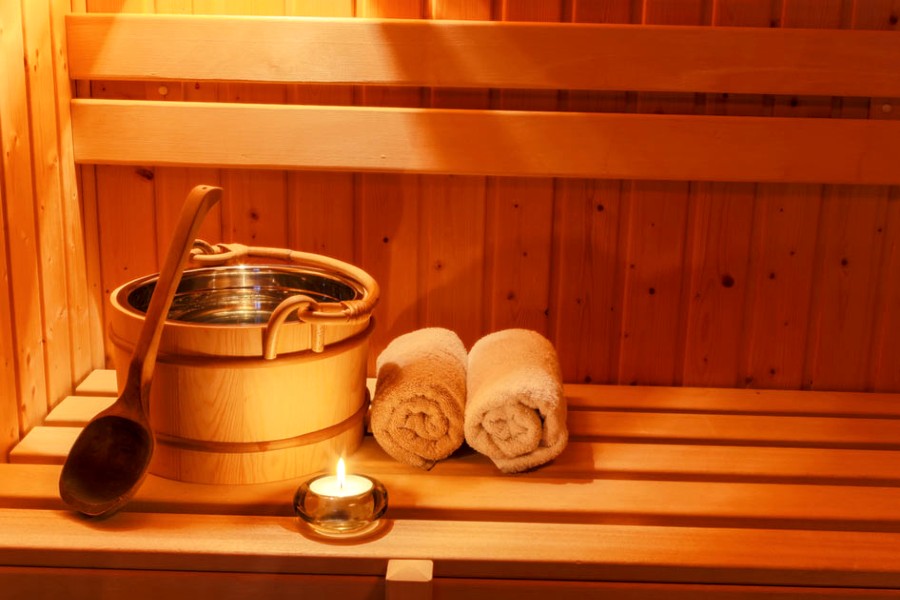
One of the most common mental health disorders, anxiety can make it difficult for sufferers to function in daily life.
From constant restlessness and fearfulness, all throughout your day; or irritability when something doesn’t go right- these are just some examples that arise because of anxiety. In severe cases, this condition could lead not only to sleep deprivation but also depression as well! However, there is hope on offer now: new treatments such as infrared sauna therapy may provide relief to sufferers. Let’s take a closer look at the infrared sauna’s feasibility into anxiety management.
Have humans always had Anxiety?
Under the Greco-Roman philosophy and medical model (c 460 BC to c 370 AD), anxiety was an identifiable condition understood both subjectively and objectively. Primarily attributed to a fear of unseen forces or calamities, the term ‘anxiety’ is believed to have derived from the Latin verb ango (to constrict). This led to early understandings of vesaniae (mental disorders) being divided into four categories:
- hallucinations
- morositates
- deliria
- and folies anomalies.
Of these four conditions, panophobia – characterized by panic terror often experienced at night without an obvious cause – was primarily associated with anxiety. Throughout the eras, as more research emerged on the effects of prolonged anxiety and stress on physical health, a growing recognition of this emotion as a legitimate mental disorder has emerged.
Even though records of anxiety date back to 460 BC, anxiety is still oftentimes neglected in healthcare systems today. But with a better understanding of its complexity and the numerous effects it has on our lives, it is slowly gaining greater recognition from medical practitioners across the globe today.
So, although anxiety has been around for centuries – well before Greco-Roman philosophers and physicians identified it – continual studies are ultimately providing invaluable insight into society’s overall well-being (both the past and present).
History tells us anxiety is a normal emotion felt by our ancestors long before social media and today’s society. If that’s true, what is the root cause of our anxiety?
What causes the feeling of being anxious?
Fear and anxiety are both integral parts of the human experience. Fear is an immediate response to a threat, either real or perceived. It triggers the fight-or-flight response and is essential for our survival in dangerous situations.
Anxiety, on the other hand, is more future-oriented and stems from our anticipation of bad outcomes. This can be anything from an upcoming job interview to a first date or even an exam that needs studying for.
It usually results in physical reactions such as increased heart rate, trembling, sweating, difficulty concentrating and restlessness. Thus, it’s important to understand how these two phenomena are linked and what triggers them in order to manage them effectively.
Recognizing when fear or anxiety is taking hold can help you regulate your emotions better so that it doesn’t overwhelm you – which can then enable us to recognize patterns in our responses and take effective actions to mitigate these before they spiral out of control.
Knowing how to recognize fear and anxiety can ultimately make us better prepared to navigate life’s uncertainties with resilience and grace. So when you do notice yourself feeling anxious, what can you do about it?
A luxurious, affordable, and overall relaxing experience may hold the answer – infrared saunas.
What are known effective methods for treating anxiety?
It’s no secret that engaging in regular physical activity provides myriad health benefits, both mentally and physically.
Recent research has verified just how powerful exercise can be when it comes to psychological well-being. Studies have found significant correlations between increased physical activity and decreased symptoms of depression and anxiety.
People who engage in regular workouts are also reported to have higher life satisfaction, improved cognitive functioning, and better overall physical health. In comparison to antidepressant medications, exercise has been demonstrated as a reliable first-line treatment for mild to moderate depression, with the added benefit of being cost-efficient.
Although there is not as much data to support its efficacy against anxiety disorders, some studies suggest that it could be an effective and accessible treatment alternative. The takeaway is clear – finding a way to incorporate physical activity into our daily lives can be massively beneficial for our overall mental well-being.
How can infrared saunas help with mental health and anxiety?
Using an infrared sauna not only provides a comfortable environment to relax and reduce the effects of stress and anxiety on our minds and bodies, but it also mimics some of our current physiological responses to exercise.
Incorporating red light therapy at home can complement the benefits of using an infrared sauna, providing additional therapeutic effects.
This is because infrared light warms the body directly, allowing the user to experience increased heart rate and steeper rises in core temperature with far less suffering than other forms of physical exercise.
By elevating one’s core temperature, users are able to lower their levels of cortisol, which is released as a result of stressful circumstances. As well as being beneficial for general well-being and relaxation, this can help us step away from our negative thought patterns by enabling us to focus on more calming activities.
Furthermore, ongoing infrared sauna use has been shown to improve sleep quality and boost moods; positive changes that have far-reaching implications for both mental well-being and overall health.
Whether you’re looking for an escape from everyday worries or just seeking an antidote for feelings of burnout, saunas provide an invaluable means for managing stress effectively and restoring your well-being balance.
Infrared sauna treatments mimic moderate exercise
As mentioned earlier, some key features of exercise as a suitable treatment for anxiety also are reflected with infrared sauna use.
The health benefits of sauna bathing have been detailed in a recent study of 50-year-old participants, all with at least one cardiovascular risk factor. Using modern medical techniques and monitoring, data was collected before, immediately after, and 30 minutes after a single 30 minute sauna session.
The results were more than surprising; they showed a significant reduction in pulse wave velocity and blood pressure as well as mean arterial pressure and left ventricular ejection time. Even more encouraging, the changes resulting from the sauna bath were sustained during the recovery phase.
The extreme heat from the infrared heaters raised the patients core body temperature to induce a deep sweat. Infrared waves easily penetrate human tissue, unlike conventional heat from traditional saunas, targeting muscle soreness, removing toxins, supporting blood pressure and improving blood circulation.
This indicates that there are some real cardiovascular benefits to sauna bathing beyond just its use for pleasure – it could help to reduce the risk of vascular diseases such as stroke or heart attack.
This new information points to a potential preventative measure we can incorporate into our lives for improved cardiovascular health other than regular exercise. Sauna bathing could be an ideal activity for those looking for something enjoyable but also beneficial to support long-lasting health problems and health conditions.
How does infrared therapy work?
Infrared saunas work through the use of advanced infrared heaters. Far infrared heat (FIR), a form of the electromagnetic spectrum, has been extensively researched and studied to show positive biological effects on things such as high blood pressure, joint pain, weight loss, sore muscles, prevention of heart failure and even Alzheimer’s disease.
Aside from far infrared, near and mid-infrared heat has become increasingly popular for its ability to stimulate cells and tissue. This waveband produces more thermal energy and its radiant heat stimulates a more intense sweat.
Today, advanced technologies have enabled new avenues of far infrared saunas and infrared heat to be utilized in therapeutic practices for a range of treatments, such as managing anxeity.
What makes infrared sauna treatment plausible is its non-invasive and cost-effectiveness, safety, and efficacy for treating various conditions.
What also makes infrared saunas good for managing anxiety?
Since the dawn of civilization, humans have connected with nature in various ways. Before roads and vehicles, we explore barefoot trails and drank from fresh and mineral-dense rivers. Before supermarkets, we harvest fruits from untamed gardens and filled our lungs with unpolluted air.
These natural interactions can still help promote our physical, mental and creative well-being today. In fact, science has now identified four ‘elements’, which are considered to be influential factors in terms of human health—Fire, Water, Earth, and Air.
Each element is associated with potential solutions to improve mental wellness that can be experienced both indoors and outdoors. For instance, visiting a sauna (Fire), participating in hydrotherapy (Water), going for a walk or hike through nature (Earth) and engaging in oxygen-rich activities such as yoga or mindful breathing exercises (Air) have all been linked to physiological responses that promote well-being and longevity.
All of these activities bring balance to the mind and body by further connecting us to our environment and its unique gifts. With better awareness of how humankind interacts with its surrounding world—and simple remedies at its disposal—individuals everywhere may find improved health through rekindling their relationship with nature’s elements.
What are other infrared sauna health benefits?
Traditional sauna therapy has been used since ancient times and has gained popularity as a traditional medical practice in the Scandinavian region.
Studies have shown that traditional saunas and infrared saunas can be effective treatments for a variety of medical conditions, including hypertension, congestive heart failure, post-myocardial infarction care, COPD, chronic fatigue, chronic pain, and addiction.
There is also evidence that regular sauna use for detoxification (or purification) – such as Waon therapy – can be helpful for those with environmentally-induced illnesses.
The main difference of traditional saunas and infrared saunas is that a traditional sauna operates with heating from a wood-burning stove or an electric heater to heat the air around body. Another form of heating by a traditional sauna is what’s known as traditional steam saunas, where steam is used to heat the wood-based room.
Infrared saunas use low-temperature infrared heat to heat the body directly. The lower temperatures inside an infrared sauna allow patients to sauna longer and help to re-energise. Infrared heat penetrates deeper than traditional saunas to provide further benefits.
Current research suggests that both traditional and infrared sauna therapies are generally safe. However, it is important to consult your doctor before beginning any form of therapy to ensure that it is appropriate for your health needs. By regularly practicing traditional or infrared sauna therapy alongside lifestyle modifications such as exercise and dietary changes, many people have experienced powerful results when treating their medical condition. If you suffer from anxiety, know that you are not alone and that there are treatments available that can help you manage your symptoms. Exercise is a great way to combat anxiety because it releases endorphins, which have mood-boosting properties. Additionally, infrared saunas provide many of the same benefits as exercise does without being as strenuous. Infrared saunas also help to detoxify the body and improve circulation. If you’re interested in trying an infrared sauna to treat your anxiety, take a look at the best infrared sauna for sale
Become a Harlem Insider!
By submitting this form, you are consenting to receive marketing emails from: Harlem World Magazine, 2521 1/2 west 42nd street, Los Angeles, CA, 90008, https://www.harlemworldmagazine.com. You can revoke your consent to receive emails at any time by using the SafeUnsubscribe® link, found at the bottom of every email. Emails are serviced by Constant Contact








